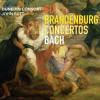Texte paru dans: / Appeared in:
*

International Record Review - (11//2013)
Pour
s'abonner / Subscription information
Linn
CKD430

0691062043021 (ID336)
The six instrumental concertos that Bach completed in March 1721 and subsequently presented to the Margrave of Brandenburg are almost certainly the most frequently recorded of all Baroque concerto set...What, then, might serve to distinguish these new accounts from the many other excellent contenders in the current catalogues?
To answer that question, we need to appreciate that modern Bach research continues to illuminate performance practice during the composer's Cöthen period and, in particular, has helped us to understand far more than ever before about the supposed pitch Bach and his performers might have chosen to use.
As Butt explains in his booklet essay, Bach's musicians might have been comparatively few in number, and it is likely that the parts in these concertos and other works would have been taken by individual instrumentalists. Bach's players were all highly accomplished virtuosi and this undoubtedly facilitated a much closer correlation between solo and ripieno textures than might be expected in most Baroque concertos, but (as Bruce Haynes has also shown) it now seems probable that the Cöthen pitch (which was in all likelihood not completely standardized) was set much lower than that used elsewhere at the time. For this new recording, the ‘tief-Cammerton' is set at A=392Hz, in other words a whole tone below modern concert pitch and a semitone lower than the A=415Hz often used by most Baroque performers today.
Why should that fact alone have such far-reaching implications? As Butt explains, ‘The low pitch - which adds an element of technical complexity - does have several significant effects on the sound of the performance. First, it is perhaps most suited to smaller rooms than the high pitch levels, which tend to render the music more penetrating, but it brings a warmth and glow to the sound that is well suited to the euphonious textures of the Brandenburg Concertos.' That assertion does receive frequent endorsement throughout this impressive set. Even at the first hearing, it is remarkable to find that this over - familiar music often sounds so different as to immediately captivate and engross the listener in a myriad different and unexpected ways, all of them refreshing and illuminating.
The Affetuoso slow movement of Concerto No. 5 in D, BWV.1050, a trio for three solo instruments alone (and most akin to a Baroque sonata slow movement in its intimacy) makes the point especially clear, but there are other consequences too.
The lower pitch, suggests Butt, also ‘tends to encourage a slightly slower but more subtle articulation for most instruments, which means that both fast and slow tempi can generate a rich array of note shapes and dynamic shadings'. Again, the musical evidence in support of this suggestion seems compelling, and is nowhere more eloquently displayed than in the 'Adagio' of Concerto No. 6, BWV.1051.
Other consequences of reduced pitch might seem less obvious to the listener, but never the less have a very significant effect upon the playability of certain passages in the Brandenburg set.
That is most obviously the case in the intimidating clarino register solo trumpet writing of the second concerto, which, says Butt, becomes ‘slightly easier to handle'. Not that this technically brilliant and apparently fearless soloist here, the wonderfully agile David Blackadder, ever needs any such concession, and his thrilling high-wire act trumpet playing throughout BWV.1047 is among the many enticements that should prompt hard-bitten Bach devotees to purchase this wonderful set!
Perhaps under normal conditions it would seem impossible to conceal the depth of scholarship and detailed preparation which underpins these outstanding realizations, and yet Butt and his team play all six Brandenburgs with such disarming spontaneity and assurance that no hint of anything drab or prosaic is ever detectable. If anything, these rich-hued, generous readings provide further compelling reasons to conclude that, in the right hands, an equitable balance between the scholarly and the musicianly can bring this, or any other music, to life in a very personal and exciting way. No matter how many times you've heard the Brandenburg Concertos before, these readings have that rare capacity to make you feel you're hearing them afresh for the very first time.
There was a time when I should
have favoured Richard Goebel's survey with Musica Antiqua Köln above all
others, for the flare and virtuosity of the third and fifth concertos
especially. However, there remains a certain clinical detachment about this
famous DG set that nowadays seems less satisfying, and both the Harmonia
Mundi set by the Akademie für Alte Musik Berlin and the English Baroque
Soloists' traversal with John Eliot Gardiner both afford fine playing but
without the coolness of the Cologne accounts. If forced to choose, I'd
probably elect for the Harmonia Mundi cycle, yet not even this comes close
to matching the richness and majesty of the Dunedin Consort performance,
which seem to provide the best of all possible worlds in this music.
Fermer la fenêtre/Close window
Cliquez l'un ou l'autre
bouton pour découvrir bien d'autres critiques de CD
Click either button for many other reviews


